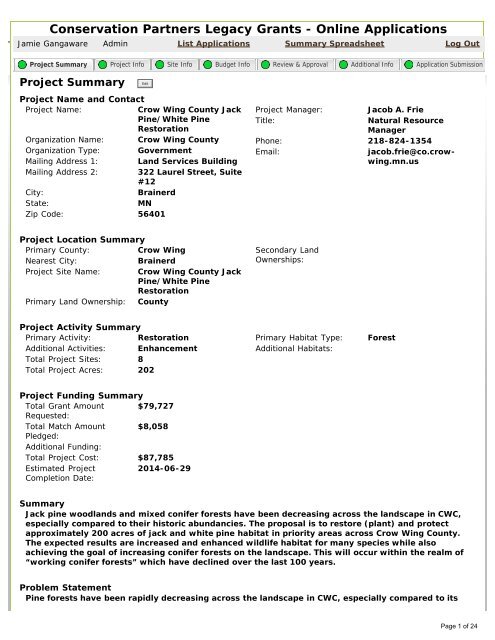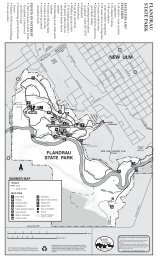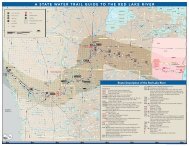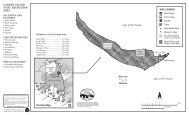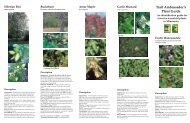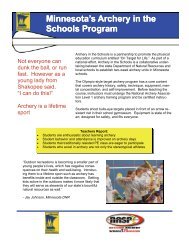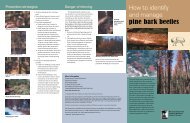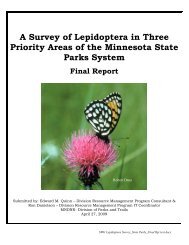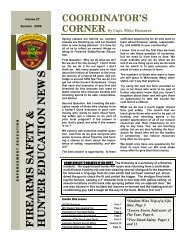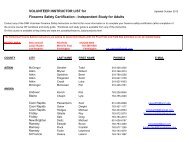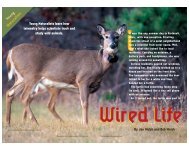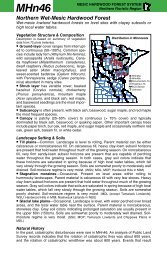Conservation Partners Legacy Grant Application - Minnesota ...
Conservation Partners Legacy Grant Application - Minnesota ...
Conservation Partners Legacy Grant Application - Minnesota ...
You also want an ePaper? Increase the reach of your titles
YUMPU automatically turns print PDFs into web optimized ePapers that Google loves.
<strong>Conservation</strong> <strong>Partners</strong> <strong>Legacy</strong> <strong>Grant</strong>s - Online <strong>Application</strong>s<br />
Jamie Gangaware Admin List <strong>Application</strong>s Summary Spreadsheet Log Out<br />
Project Summary Project Info Site Info Budget Info Review & Approval Additional Info <strong>Application</strong> Submission<br />
Project Summary<br />
Project Name and Contact<br />
Project Name:<br />
Crow Wing County Jack<br />
Pine/White Pine<br />
Restoration<br />
Organization Name: Crow Wing County<br />
Organization Type: Government<br />
Mailing Address 1: Land Services Building<br />
Mailing Address 2: 322 Laurel Street, Suite<br />
#12<br />
City:<br />
Brainerd<br />
State:<br />
MN<br />
Zip Code: 56401<br />
Project Manager:<br />
Jacob A. Frie<br />
Title:<br />
Natural Resource<br />
Manager<br />
Phone: 218-824-1354<br />
Email:<br />
jacob.frie@co.crowwing.mn.us<br />
Project Location Summary<br />
Primary County:<br />
Crow Wing<br />
Nearest City:<br />
Brainerd<br />
Project Site Name: Crow Wing County Jack<br />
Pine/White Pine<br />
Restoration<br />
Primary Land Ownership: County<br />
Secondary Land<br />
Ownerships:<br />
Project Activity Summary<br />
Primary Activity:<br />
Restoration<br />
Additional Activities: Enhancement<br />
Total Project Sites: 8<br />
Total Project Acres: 202<br />
Primary Habitat Type:<br />
Additional Habitats:<br />
Forest<br />
Project Funding Summary<br />
Total <strong>Grant</strong> Amount $79,727<br />
Requested:<br />
Total Match Amount $8,058<br />
Pledged:<br />
Additional Funding:<br />
Total Project Cost: $87,785<br />
Estimated Project<br />
2014-06-29<br />
Completion Date:<br />
Summary<br />
Jack pine woodlands and mixed conifer forests have been decreasing across the landscape in CWC,<br />
especially compared to their historic abundancies. The proposal is to restore (plant) and protect<br />
approximately 200 acres of jack and white pine habitat in priority areas across Crow Wing County.<br />
The expected results are increased and enhanced wildlife habitat for many species while also<br />
achieving the goal of increasing conifer forests on the landscape. This will occur within the realm of<br />
“working conifer forests” which have declined over the last 100 years.<br />
Problem Statement<br />
Pine forests have been rapidly decreasing across the landscape in CWC, especially compared to its<br />
Page 1 of 24
historic abundancy on the landscape. Records indicate that 15% of Crow Wing County (CWC) was<br />
in conifer covertype in presettlement conditions. By the end of the late 1990's, that number has<br />
shrunk to just over 4%. On CWC administered/managed land, the amount of jack pine covertype<br />
acres has shrunk by an astonashing 70% in the last 12 years (from 1997 to 2009) from almost<br />
1,500 acres to just over 425 acres. A combination of large-scale influences have occured over the<br />
last 100 years to create these conditions. First, human encroachment and subsequent need for fire<br />
supression to protect real estate investments has reduced the chances of jack pine's principal<br />
means of establishment: fire. Second, a drastic increase in local deer populations and densities<br />
have made jack pine an easy and nutritious target for herbivory. Lastly, as a result of challenges<br />
regenerating jack pine, CWC has, over the last 5 years, begun to switch its planted species to one<br />
that may not be best suited for the site, but instead resistant to deer and small mammal browse.<br />
This has the potential for drastic ecological influences over the landscape (i.e., matching the<br />
best/most appropriate species at the site level). In the case of white pine, its decline can be traced<br />
to the introduction of a blister-rust fungus and the intense intense wild fires and land clearing that<br />
followed off the complete clearcutting of mixed pine forests in the late 1800’s – early 1900’s. Its<br />
terrestrial habitat has declined by more than 50% since the 1890s in the Pine Moraine and<br />
Outwash Plains subsection (“Tomorrow’s Habitat”, p. 174).<br />
Project Objectives<br />
The expected result is 89 acres of restored jack pine habitat and 112 acres of restored white pine<br />
mixed-forest habitat. The benefits of the project include wildlife habitat restoration and helping to<br />
restore species historic range of occurrence over the landscape. Jack pine woodlands provide<br />
important habitat for primarily forest edge and shrub transitional species. Because some sites have<br />
aspen and oak inclusions within the plantable area, the area is well-suited for a variety of wildlife,<br />
and the effect of a monoculture "plantation" feel will be mitigated. Both jack and white pine is a<br />
commercially diverse species, used for pulpwood, lumber, telephone poles, railroad ties, and<br />
biomass among other uses. As the respective stands approach "rotation age", management<br />
strategies will focus on silvicultural tools that promote natural seeding methods as a principal<br />
regeneration strategy.<br />
Methods<br />
PRE-STEP A: Some planting sites have not been harvested or are currently in the process of being<br />
harvested. They will need to be harvested first before planting can be conducted. Most sites are<br />
summer timber sales with random skidding scarification as the site preparation method. STEP 1:<br />
Some planting sites have not been scarified adequately during the previous timber harvest in order<br />
to expose mineral soil for micro-habitats for seedlings. They will need mechanical scarification in<br />
the form of a “disc trencher.” This will be contracted out. Other planting sites will be directly<br />
planted without additional scarification. All white pine sites will be planted in this way. STEP 2:<br />
Tree seedlings will be ordered and planted on the planting sites. The trees will be planted by either<br />
<strong>Minnesota</strong> <strong>Conservation</strong> Corps (MCC) staff or contracted out in a bid process. The contract will be<br />
administered by CWC Natural Resource Managers. STEP 3: Browse protection measures will be put<br />
into place. Several methods are available, and they vary by site and potential severity of browse<br />
damage. At a minimum, every site will receive some form of protection. This includes bud caps<br />
secured over the terminal “shoot”, mesh tubes placed over the seedlings, and/or deer repellant<br />
(i.e., PlantSkydd). All protection measures will be performed by either MCC staff or contracted out<br />
to highest bidder. The protection contracts will be administered by CWC Natural Resource<br />
Managers. STEP 4: Regeneration/mortality surveys will be conducted by CWC Natural Resource<br />
Managers one year after the initial planting in the spring. This will ensure plantings are adequately<br />
growing and surviving. If survival and stocking is inadequate, the site will be supplementally<br />
planted and protected.<br />
Project Timeline<br />
Time Frame<br />
Goal<br />
Spring, 2011 Plant sites 3, 5, & 8<br />
Fall, 2011 Site prep sites 1 & 2<br />
Fall, 2011<br />
Gather jack pine seeds from local seed<br />
orchard<br />
Fall, 2011 Protect sites 3, 5, & 8<br />
Page 2 of 24
Spring, 2012 Plant sites 1, 2, 4, 6, & 7<br />
Spring, 2012 Regeneration survey of sites 3, 5, & 8<br />
Fall, 2012 Protect sites 1 thru 8<br />
Spring, 2013 Regeneration survey of sites 1, 2, 4, 6, & 7<br />
Fall, 2013 Protect sites 1 thru 8<br />
Identify short and long term maintenance and management work required to sustain this project and source(s)<br />
of funding<br />
Work needed Who is responsible Funding source<br />
Plant all sites (JP or WP) Contractor or MCC <strong>Grant</strong><br />
Site prep Contractor <strong>Grant</strong><br />
Gather jack pine seeds CWC staff w/STS crew In-kind<br />
Protect all sites (i.e., bud cap, repellent, Contractor or MCC <strong>Grant</strong><br />
etc.)<br />
Regeneration survey CWC staff In-kind<br />
Page 3 of 24
<strong>Conservation</strong> <strong>Partners</strong> <strong>Legacy</strong> <strong>Grant</strong>s - Online <strong>Application</strong>s<br />
Jamie Gangaware Admin List <strong>Application</strong>s Summary Spreadsheet Log Out<br />
Project Summary Project Info Site Info Budget Info Review & Approval Additional Info <strong>Application</strong> Submission<br />
Project Information<br />
Answer each of the following questions in 1000 characters or less; descriptions/definitions are<br />
available in the Criteria and Scoring Table.<br />
1. Describe the local support for this project.<br />
A CWC board motion on September 14, 2010 approved matching funds and general<br />
support for the project. CWC commissioners support the project in the form of a<br />
commitment letter. Support was also given by the Land Services Supervisor to commit<br />
resources for the proposal in the form of a written letter. The MFRC North Central<br />
Landscape Committee supports the planting of pine in the proposed planing area<br />
ecological regions. Also, a report by the MN DNR White Pine Regeneration Strategies<br />
Work Group mentioned that counties that establish white pine should be recognized and<br />
receive priority in the allocation of funds. In one planting site (City of Baxter), plans for<br />
under planting white pine were sent to area landowners, including the city council,<br />
seeking input. No opposition was voiced.<br />
2. Describe the degree of collaboration for this project.<br />
CWC Public Land Management has been a member of the <strong>Minnesota</strong> Tree Improvement<br />
Cooperative (MTIC) since 1985. The MTIC and CWC have a shared goal of selecting<br />
and breeding trees which grow faster, have better form, and are more disease resistant<br />
than those which currently exist. CWC also has two jack pine seed orchards in the<br />
county which means that CWC is in a great position to grow outstanding jack pine.<br />
Seeds for planting will be derived from this "local" ecotype source for planting.<br />
<strong>Minnesota</strong> <strong>Conservation</strong> Corps and/or local Sentanced to Serve crews may be used to<br />
help plant/protect trees and gather local seed sources.<br />
3. Describe any urgency associated with this project.<br />
This project will conduct planting without the use of herbicides and with limited site<br />
preparation. In two jack pine sites, the seed bed will be prepared using “trencher”<br />
mechanical scarifier. Because of the lack of vegetation control, it is essential that the<br />
timing of plantings occurs soon after harvest or disturbance. This will limit the potential<br />
for competition problems. On some sites, harvesting the over story before planting will<br />
capture mortality in a way that waiting cannot.<br />
4. Discuss if there are multiple benefits resulting from your project, identifying those<br />
species, habitats, etc.<br />
Both jack and white-red pine habitats are listed as a “Key Habitat” in the MN Wildlife<br />
Action Plan. Jack pine habitat is suitable for the Connecticut Warbler and the Nashville<br />
Warbler. Because many sites have hardwood inclusions, the effect of a monoculture<br />
"plantation" feel will mitigated. This will increase the visual quality. Multiple sites occur<br />
near riparian management zones in recently harvested areas. Absent of trees, water<br />
quality may be threatened due to increased runoff and/or erosion.<br />
5. Discuss the habitat benefits resulting from your project.<br />
Both jack and white-red pine habitats are listed as a “Key Habitat” in the MN Wildlife<br />
Action Plan. Jack pine habitat is suitable for the Connecticut Warbler, the Nashville<br />
Warbler, and the Black-Billed Cuckoo. Their habitats are home to the second and third<br />
most species richness among the nine terrestrial habitats listed (p. 174). Jack pine<br />
woodlands provide important habitat for primarily forest edge and shrub transitional<br />
species. Small mammals include red squirrels, red-backed voles, and white-footed<br />
mice. Because some planting sites have aspen and oak inclusions within the plantable<br />
area, the area is well-suited for a variety of wildlife, and the effect of a monoculture<br />
"plantation" feel will mitigated. White pine sites in particular provide vital thermal cover<br />
in the winter to mammals.<br />
6. Describe how your project is consistent with sound conservation science.<br />
Page 4 of 24
According to the “Field Guide to the Native Plant Communities of <strong>Minnesota</strong>”, the areas<br />
to be planted to jack pine fit well with the ecological history of the site (i.e., full<br />
sunlight following moderate to severe disturbance patterns). The same goes for white<br />
pine plantings (i.e., mixed conifer forest in a non-monoculture planting arrangement).<br />
The planting methods and silvicultural system concurs with the Manager’s Handbook for<br />
species In The North Central States.<br />
7. Indicate if your project is adjacent to protected lands, describing those lands<br />
(ownership, public access, etc.)<br />
This project does not involve work near any protected lands. However, there are areas<br />
of private land adjacent to some of the project locations. Adjacent lands are all county<br />
lands which have wetland, wildlife, and conservation protection values associated with<br />
them. Multiple public uses are allowed.<br />
8. Discuss if there is full funding secured for this project and the sources of funding.<br />
<strong>Grant</strong> and match dollars will cover all costs for the projects.<br />
9. Discuss if CPL <strong>Grant</strong> funds will supplement or supplant existing funding. Discuss<br />
how these CPL funds will impact your organization's current budget.<br />
CPL <strong>Grant</strong> funds will supplement existing funding. CWC has funds available each year<br />
for annual small-scale conifer plantings (i.e., maintenance). However, this project’s<br />
scope and effects go beyond that available fund, in that the goal is to enhance and<br />
increase wildlife habitat by creating new plantings in order to achieve landscape level<br />
objectives. Costly deer browse protection has been an increasing problem, financially,<br />
in our efforts to regenerate jack/white pine.<br />
10. Describe public access at project site for hunting and fishing, identifying all open<br />
seasons.<br />
Public hunting, trapping, and fishing (where applicable) is allowed at all of the project<br />
sites. Open hunting seasons includes whitetail deer, black bear, wild turkey, grouse,<br />
rabbit, squirrel, fox, waterfowl, etc. All species listed in the MN DNR Hunting/Fishing<br />
Regulations are open to hunting and fishing on CWC managed lands.<br />
11. Describe the sustainability of your project.<br />
With the protection measures proposed in this project including browse protection and<br />
regeneration surveys, there is a high probability for success. The lands (most of which<br />
are tax-forfeited) are almost assuredly not going to be sold and our office will continue<br />
to exist in perpetuity for the primary purposes of “forest management” per state<br />
statutes. Managers of the forest are Natural Resource Professionals, trained and<br />
qualified at accredited institutions for the purpose of growing and tending forests.<br />
12. Discuss use of native vegetation (if applicable).<br />
CWC has two jack pine seed orchards which means that it is in a great position to grow<br />
outstanding jack pine. The seeds will be (have been in the past) collected from this<br />
"local" ecotype source for planting. White pine will be grown at the MN DNR nurseries.<br />
Also, all planting sites have a completed Native Plant Community survey that shows<br />
good to excellent suitability for all sites for both species planted. Jack pine planting<br />
sites are FDc24 and FDc34. White pine planting sites are MHc26.<br />
13. Discuss your budget and why it is cost effective.<br />
The budget includes only the necessary costs to ensure that jack pine and white pine<br />
mixed forests are restored and protected. The estimated costs are based on recent<br />
supplies ordered and contracts paid in 2009. Seedlings will be ordered at high volume<br />
from a qualified grower (DNR) and planted at multiple planting sites. This means<br />
economies of scale plays in our favor. Very limited monies are being spent on site<br />
preparation costs and administration costs are matched.<br />
14. Describe your organization's ability to successfully complete this work, including<br />
experience in the area of interest and ability to successfully implement the<br />
proposed project. Include descriptions of your most recent grant experience and if<br />
the expected outcomes were achieved.<br />
CWC-Public Land Management manages over 103,000 acres of tax-forfeited forestland<br />
and is third-party dual-certified to two of the leading certification bodies in the world:<br />
the Forest Stewardship Council (FSC) and the Sustainable Forestry Initiative (SFI).<br />
Page 5 of 24
CWC-Public Land Management has qualified and dedicated natural resource<br />
professionals and support staff to accomplish and complete this project. CWC has been<br />
successful recently in securing $100,000 in grant funds from the Iron Range Resources<br />
and Rehabilitation Board (IRRRB) to develop Phase 1 of the Milford Mine Memorial Park<br />
near Crosby, MN. Project development of Phase 1 will be completed in September<br />
1010. Proposals and outcomes for Phase 1 of the park development project have gone<br />
smoothly and are near completion.<br />
15. Discuss how your project supports landscape level plans. Use additional sources for<br />
information if needed or available.<br />
The MFRC’s North Central Landscape Committee goals for the dry-mesic pine-oak<br />
ecological system, is to establish jack pine in the young age classes (p. 12). Broad<br />
landscape goals for the Pine Moraines & Outwash Plain are to increase jack and white<br />
pine over the landscape. Currently, two landtype associations within the subsection that<br />
occur in CWC have declining jack pine covertype numbers. This planting project will<br />
serve to increase both jack and white pine to their historic range of variability.<br />
16. Discuss how your project supports species plans. Use additional sources for<br />
information if needed or available.<br />
The project promotes the establishment of early successional forest types (i.e., jack<br />
pine woodland), which is an important habitat for ruffed grouse and woodcock. This<br />
project also promotes mixed pine forests (i.e., white pine) which are important habitat<br />
for white-tailed deer, spruce grouse, and pine martin (p. 13). These species plans are<br />
supported by the MN DNR’s “Vision for Wildlife and its Use – Goals and Outcomes,<br />
2005-2012.” The MN DNR’s “Long-Range Plan for Wild Turkey in <strong>Minnesota</strong>” states that<br />
food and roosting cover are the two most important habitat components for wild<br />
turkeys during the fall and winter. Turkeys use mature hardwood and conifer stands for<br />
roosting (p. 4). During winter, the use of conifers by wild turkeys for roosting might<br />
provide additional thermal protection. SFRMP (DNR) plans promote increasing jack pine<br />
on the landscape as well as introducing white pine as a mixed component in forests<br />
which this project supports.<br />
17. Discuss how your project conforms to the Statewide <strong>Conservation</strong> and Preservation<br />
Plan.<br />
The Statewide <strong>Conservation</strong> and Preservation Plan (SCPP) has identified many critical<br />
land habi¬tats throughout the state based on an integrated approach that considers<br />
such issues as SGCN, out¬door recreation such as hunting and fishing, protec¬tion of<br />
water quality, and threats to these resources. All of the project sites are open to<br />
outdoor recreation such as hunting and fishing. Also, the focus of this project is the<br />
restoration and protection of jack and white pine mixed forests which are key habitats<br />
for a large variety of SGCN. The SCPP allows consid¬erable flexibility for conservation<br />
of lands and ap¬propriate protection of economic activity such as logging or other<br />
compatible uses. This project conforms very well to the SCPP in that it focuses on<br />
critical habitat protection and restoration, as well as the opportunity for some economic<br />
activity in the future (p. 63).<br />
18. Discuss how your project conforms to the State Wildlife Action Plan (if applicable).<br />
Both jack and white-red pine habitats are listed as a “Key Habitat” in the MN Wildlife<br />
Action Plan. Jack pine habitat is suitable for the Connecticut Warbler and the Nashville<br />
Warbler. Their habitats are home to the second and third most species richness among<br />
the nine terrestrial habitats listed (“Tomorrow’s Habitat”, p. 174).<br />
Page 6 of 24
<strong>Conservation</strong> <strong>Partners</strong> <strong>Legacy</strong> <strong>Grant</strong>s - Online <strong>Application</strong>s<br />
Jamie Gangaware Admin List <strong>Application</strong>s Summary Spreadsheet Log Out<br />
Project Summary Project Info Site Info Budget Info Review & Approval Additional Info <strong>Application</strong> Submission<br />
Site Information<br />
*you may group your project sites together as long as land ownership, activity and habitat information is the same for the land manager<br />
Land Manager<br />
Name:<br />
Organization:<br />
Title:<br />
Kirk Titus<br />
Crow Wing County<br />
Land Services<br />
Supervisor<br />
Site Information<br />
Land Ownership:<br />
County<br />
Site Name(s): 1<br />
Activity:<br />
Restoration<br />
Habitat:<br />
Forest<br />
Site Information<br />
Land Ownership:<br />
County<br />
Site Name(s): 2<br />
Activity:<br />
Restoration<br />
Habitat:<br />
Forest<br />
Site Information<br />
Land Ownership:<br />
County<br />
Site Name(s): 3<br />
Activity:<br />
Restoration<br />
Habitat:<br />
Forest<br />
Site Information<br />
Land Ownership:<br />
County<br />
Site Name(s): 4<br />
Activity:<br />
Restoration<br />
Habitat:<br />
Forest<br />
Site Information<br />
Land Ownership:<br />
County<br />
Site Name(s): 5<br />
Activity:<br />
Restoration<br />
Habitat:<br />
Forest<br />
Site Information<br />
Land Ownership:<br />
County<br />
Site Name(s): 6<br />
Activity:<br />
Restoration<br />
Habitat:<br />
Forest<br />
Site Information<br />
Land Ownership:<br />
County<br />
Site Name(s): 7<br />
Activity:<br />
Restoration<br />
Habitat:<br />
Forest<br />
Site Information<br />
Land Ownership:<br />
County<br />
Site Name(s): 8<br />
Phone: 218-824-1138<br />
Email:<br />
kirk.titus@co.crowwing.mn.us<br />
Acres: 27<br />
Click here to View Site Map<br />
Acres: 9<br />
Click here to View Site Map<br />
Acres: 13<br />
Click here to View Site Map<br />
Acres: 20<br />
Click here to View Site Map<br />
Acres: 21<br />
Click here to View Site Map<br />
Acres: 70<br />
Click here to View Site Map<br />
Acres: 13<br />
Click here to View Site Map<br />
Acres: 29<br />
Click here to View Site Map<br />
Page 7 of 24
Activity:<br />
Habitat:<br />
Restoration<br />
Forest<br />
Page 8 of 24
Legend<br />
FY2011 CPL Project Site<br />
¯<br />
0 2 4 8 Miles<br />
CPL FY11-049<br />
Crow Wing County Jack Pine/<br />
White Pine Restoration<br />
Crow Wing County<br />
LSOHC Northern Forest Planning Section<br />
Page 9 of 24<br />
Crested by J. Gangaware, 10/2010
<strong>Conservation</strong> <strong>Partners</strong> <strong>Legacy</strong> <strong>Grant</strong>s - Online <strong>Application</strong>s<br />
Jamie Gangaware Admin List <strong>Application</strong>s Summary Spreadsheet Log Out<br />
Project Summary Project Info Site Info Budget Info Review & Approval Additional Info <strong>Application</strong> Submission<br />
Budget Information<br />
Organization's Fiscal Contact Information<br />
Name:<br />
Kirk Titus<br />
Title:<br />
Land Services<br />
Supervisor<br />
Email:<br />
kirk.titus@co.crowwing.mn.us<br />
Phone: 218-824-1138<br />
Street Address 1:<br />
Land Services Building<br />
Street Address 2:<br />
322 Laurel Street, Suite<br />
#12<br />
City:<br />
Brainerd<br />
State:<br />
MN<br />
Zip Code: 56401<br />
Budget Subtotals<br />
Budget Item <strong>Grant</strong> Match Total<br />
Personnel $6,560 $1,440 $8,000<br />
Contracts $37,650 $37,650<br />
Fee Acquisition with PILT<br />
Fee Acquisition without PILT<br />
Easement Acquisition<br />
Easement Stewardship<br />
Travel (in-state) $1,075 $1,075<br />
Professional Services<br />
DNR Land Acquisition Cost<br />
Equipment/Tools/Supplies $35,517 $5,543 $41,060<br />
Additional Budget Items<br />
Total: $79,727 $8,058 $87,785<br />
In-kind Total Cash Total<br />
$2,515 $6,013<br />
Details<br />
Personnel<br />
Name Title / work to be completed Amount <strong>Grant</strong>/Match In-kind/Cash<br />
Jacob Frie JP Seed collection oversight $256 <strong>Grant</strong><br />
Jacob Frie Seedling plant/prot.oversight $5,696 <strong>Grant</strong><br />
Jacob Frie Regeneration surveys $512 <strong>Grant</strong><br />
Jacob Frie Trenching site prep oversight $96 <strong>Grant</strong><br />
Jacob Frie Seedling plant/prot oversight $1,440 Match In-kind<br />
Totals <strong>Grant</strong>: $6,560 Match: $1,440 Total: $8,000<br />
Contracts<br />
Contractor Name Contracted Work Amount <strong>Grant</strong>/Match In-kind/Cash<br />
To Be Determined Site prep, plant, and protect $2,793 <strong>Grant</strong><br />
To Be Determined Planting jack/white pine sites $6,473 <strong>Grant</strong><br />
To Be Determined Bud capping/ tubing pine sites $19,880 <strong>Grant</strong><br />
To Be Determined Repellent application $8,504 <strong>Grant</strong><br />
Totals <strong>Grant</strong>: $37,650 Match: $0 Total: $37,650<br />
Travel (in-state)<br />
Use Purpose Amount <strong>Grant</strong>/Match In-kind/Cash<br />
Oversight Contract/regen site oversight $1,075 Match In-kind<br />
Totals <strong>Grant</strong>: $0 Match: $1,075 Total: $1,075<br />
Page 10 of 24
Equipment/Tools/Supplies<br />
Item Purpose Amount <strong>Grant</strong>/Match In-kind/Cash<br />
Tree seedlings Planting for generation $16,031 <strong>Grant</strong><br />
Plantskyd Browsing repellent $3,546 <strong>Grant</strong><br />
Mesh tubes/ White pine protection<br />
$15,470 <strong>Grant</strong><br />
stakes<br />
Printing paper Bud caps for protection $470 <strong>Grant</strong> Cash<br />
Tree seedlings Planting for generation $5,543 Match Cash<br />
Totals <strong>Grant</strong>: $35,517 Match: $5,543 Total: $41,060<br />
Page 11 of 24
<strong>Conservation</strong> <strong>Partners</strong> <strong>Legacy</strong> <strong>Grant</strong>s - Online <strong>Application</strong>s<br />
Jamie Gangaware Admin List <strong>Application</strong>s Summary Spreadsheet Log Out<br />
Project Summary Project Info Site Info Budget Info Review & Approval Additional Info <strong>Application</strong> Submission<br />
Project Review and Approval<br />
A Project Review and Approval Form must be completed by each Land Manager named<br />
within the Site Info tab and Land Managers only need to complete one form for all sites<br />
they manage. Submitting this form fulfills the following requirements:<br />
Provides the results of the Natural Heritage Database Review,<br />
Allows for technical review of the project by the Land Manager, and<br />
Verifies that the public agency approves the work to be done (or acquisition) on land<br />
they manage.<br />
You, as the applicant, are responsible for meeting with the Land Manager and receiving a<br />
completed Project Review and Approval Form. This form must contain an original signature<br />
from the Land Manager and you must upload it below as a PDF.<br />
Each project will require at least one Project Review and Approval form. You may attach<br />
up to 4 forms on this page, but if you need more room you may attach up to three more<br />
on the "Additional Info" tab. If your project is working under 3 Land Managers, you must<br />
receive and submit a form from each manager.<br />
No late Project Review and Approval Forms will be accepted. <strong>Application</strong>s lacking any<br />
necessary approval forms will be deemed incomplete and not considered for funding.<br />
Answer the following questions, then attach the form(s)<br />
Yes Natural Heritage elements were found within my project site(s):<br />
Name the site(s) and their associated Land Managers:<br />
Site #8: City of Baxter – section 2 (CWC, City of Baxter, and Private) Site #6: City of<br />
Crosslake – section 14/23 (CWC, MN DNR, and Private) Site #3: Mission Township –<br />
section 4 (CWC, MN DNR, and Private) Site #4: Ideal Township – section 27 (MN DNR<br />
and Private)<br />
Name the elements found:<br />
Discuss any interaction or impact to these elements and the recommended<br />
mitigation / avoidance measures you will take within your project to protect these<br />
elements:<br />
Site 8, City of Baxter, section 2, which has<br />
, will have<br />
interaction to the NHDB element. Because the plantings will occur in April or May (early<br />
spring), no impact on the elements will occur. This is because<br />
(SOURCE: <strong>Minnesota</strong> DNR Div. of Ecological Resources Review Fact Sheet:<br />
Recommendations for Avoiding and Minimizing Impacts to ).<br />
Project Review and Approval Forms<br />
Uploaded Form 1<br />
Page 12 of 24
Page 13 of 24
Page 14 of 24
Page 15 of 24
Page 16 of 24
Page 17 of 24
Page 18 of 24
<strong>Conservation</strong> <strong>Partners</strong> <strong>Legacy</strong> <strong>Grant</strong>s - Online <strong>Application</strong>s<br />
Jamie Gangaware Admin List <strong>Application</strong>s Summary Spreadsheet Log Out<br />
Project Summary Project Info Site Info Budget Info Review & Approval Additional Info <strong>Application</strong> Submission<br />
Additional Information<br />
List any additional details about your project here. Include your organization's history or charter to<br />
receive private contributions for local conservation or habitat projects. This is not required.<br />
The Land Services Department contains three units; 1.) Environmental Services (ES), 2.) Public Land<br />
Management (PLM) and 3.) Property Valuation and Classification (PVC) 1.) ES is responsible for planning and<br />
zoning functions, solid waste management, and county survey and addressing functions. 2.) PLM is<br />
responsible for managing tax forfeit property. PLM is responsible for the County’s forestry, recreation and<br />
related land management activities encompassing 103,000 acres of county public forest land. 3.) PVC performs<br />
the annual valuation and classification of property values county wide for property tax purposes under a<br />
process established by the state legislature. PLM is a unit within the Crow Wing County Land Services<br />
Department.<br />
Supplemental Documents<br />
If you / your project does not need to upload any of these documents, you may leave these upload boxes empty.<br />
Upload additional information here, limited to Partner Commitment Letters, Letters of Support, Easement<br />
information, etc. You may email easement information only if it exceeds size limit while trying to submit the<br />
application; all other supporting documentation must be uploaded. Reference CPL <strong>Application</strong> # and name when<br />
emailing (provided upon application submission) or your email will be returned. Send emails to<br />
LSCPL<strong>Grant</strong>s.DNR@state.mn.us<br />
Uploaded Document 1<br />
Page 19 of 24
Page 20 of 24
Page 21 of 24
<strong>Conservation</strong> <strong>Partners</strong> <strong>Legacy</strong> <strong>Grant</strong>s - Online <strong>Application</strong>s<br />
Jamie Gangaware Admin List <strong>Application</strong>s Summary Spreadsheet Log Out<br />
Project Summary Project Info Site Info Budget Info Review & Approval Additional Info <strong>Application</strong> Submission<br />
Final <strong>Application</strong> Submission<br />
This completes your CPL <strong>Grant</strong> <strong>Application</strong>. Please take the time to revisit the previous sections and make sure<br />
you have entered everything completely and correctly. Once you hit the submit button below, you will not be able<br />
to return to this application to make changes.<br />
I certify that I have read the <strong>Conservation</strong> <strong>Partners</strong> <strong>Legacy</strong> <strong>Grant</strong>s Program Request for Proposal,<br />
Program Manual and other program documents, and have discussed this project with the<br />
appropriate public land manager, or private landowner and easement holder.<br />
I certify I am authorized to apply for and manage these grant and match funds, and the project<br />
work by the organization or agency listed below. I certify this organization to have the financial<br />
capability to compete this project and that it will comply with all applicable laws and regulations.<br />
I certify that all of the information contained in the application is correct as of the time of the<br />
submission. If anything should change, I will contact CPL <strong>Grant</strong> Staff immediately to make<br />
corrections.<br />
I certify that if funded I will give consideration to and make timely written contact to <strong>Minnesota</strong><br />
<strong>Conservation</strong> Corps or its successor for consideration of possible use of their services to contract<br />
for restoration and enhancement services. I will provide CPL staff a copy of that written contact<br />
within 10 days after the execution of my grant, should I be awarded.<br />
I certify that I am aware at least one Project Review and Approval form is required for every<br />
application and I must submit all completed forms by uploading them into this application. I have<br />
attached one form as necessary for each different Land Manager within my project.<br />
I am aware that by typing my name in the box below, I am applying my signature to this online<br />
document.<br />
Signature:<br />
Title:<br />
Jacob A. Frie<br />
Natural Resource<br />
Manager<br />
Organization / Agency: Crow Wing County<br />
Date: 2010-09-16<br />
Page 22 of 24
<strong>Conservation</strong> <strong>Partners</strong> <strong>Legacy</strong> <strong>Grant</strong> Program<br />
FY2011 Round 1 Technical Review Comments and Scoring, Regional and Divisional Directors Comments<br />
Proj<br />
ID<br />
49<br />
Organization<br />
Name<br />
Crow Wing<br />
County<br />
Project Name<br />
Crow Wing<br />
County Jack<br />
Pine/White<br />
Pine<br />
Restoration<br />
Technical Review<br />
Committee Scoring<br />
Comments<br />
Amtount<br />
Requested<br />
Score<br />
Technical Review<br />
Committee Final<br />
Rank Comments<br />
Regional<br />
Comments<br />
Meets<br />
Regional<br />
Plan? Rank Region<br />
County land, open<br />
to public use $79,727 143 Y 2<br />
Division<br />
Director's<br />
Comments<br />
This project<br />
fits better,<br />
includes<br />
both plant<br />
and protect;<br />
no question<br />
of<br />
supplanting.<br />
General<br />
ranking<br />
comments- all<br />
habitat<br />
projects<br />
All are good<br />
projects, meet<br />
goals of<br />
program. All<br />
should move<br />
forward.<br />
All could have<br />
had better<br />
partnerships--<br />
go to NGOs for<br />
$$ and<br />
support.<br />
County projects--tree<br />
planting: is it<br />
supplanting? Are<br />
these over and above<br />
regular funding?<br />
Land purchases<br />
have more<br />
urgency than<br />
plantings.<br />
No fluff in the<br />
costs for any<br />
of these.<br />
If need to cut,<br />
spread $$ out<br />
among all<br />
applicants.<br />
Crow Wing County_49_Jack Pine<br />
7)Sound<br />
<strong>Conservation</strong><br />
Science<br />
8)Adjacent<br />
to<br />
Protected<br />
Lands<br />
9)Full<br />
Funding<br />
of<br />
Project<br />
10)Supplants<br />
Existing<br />
Funding<br />
11)Public<br />
Access<br />
for<br />
Hunting<br />
and<br />
Fishing<br />
13)Use of<br />
Native<br />
Plant<br />
Materials<br />
1)Amount<br />
of Habitat<br />
2)Local<br />
Support<br />
3)Degree of<br />
Collaboration 4)Urgency<br />
5)Multiple<br />
Benefits<br />
6)Habitat<br />
Benefits<br />
12)Sustainability<br />
6.00 8.00 2.00 2.00 2.00 3.00 5.00 1.00 9.00 5.00 10.00 7.00 9.00 8.00<br />
8.00 7.00 6.00 5.00 10.00 9.00 8.00 8.00 7.00 6.00 10.00 9.00 9.00 8.00<br />
8.00 8.00 8.00 6.00 9.00 9.00 9.00 6.00 7.00 3.00 10.00 10.00 10.00 7.00<br />
9.00 9.00 8.00 6.00 7.00 6.00 9.00 10.00 8.00 4.00 10.00 8.00 10.00 8.00<br />
AVERAGES 7.75 8.00 6.00 4.75 7.00 6.75 7.75 6.25 7.75 4.50 10.00 8.50 9.50 7.75<br />
TOTAL<br />
SCORE 143.25<br />
14)Budget<br />
and Cost<br />
Effectiveness<br />
Page 23 of 24
15)Capacity to<br />
Successfully<br />
Complete Work<br />
16)Supports<br />
Existing<br />
Landscape Level<br />
Plans<br />
18)Conforms to<br />
Statewide <strong>Conservation</strong><br />
and Preservation Plan<br />
17)Supports<br />
Species Plans<br />
9.00 7.00 8.00 7.00 7.00<br />
9.00 8.00 8.00 8.00 8.00<br />
9.00 10.00 8.00 8.00 8.00<br />
8.00 9.00 9.00 8.00 8.00<br />
8.75 8.50 8.25 7.75 7.75<br />
19)Conforms to State<br />
Wildlife Action Plan<br />
Page 24 of 24


